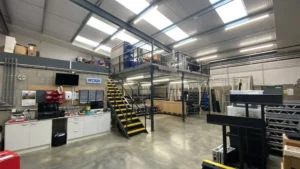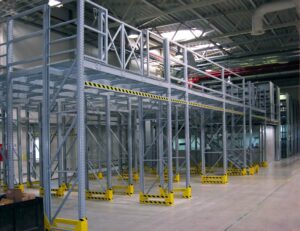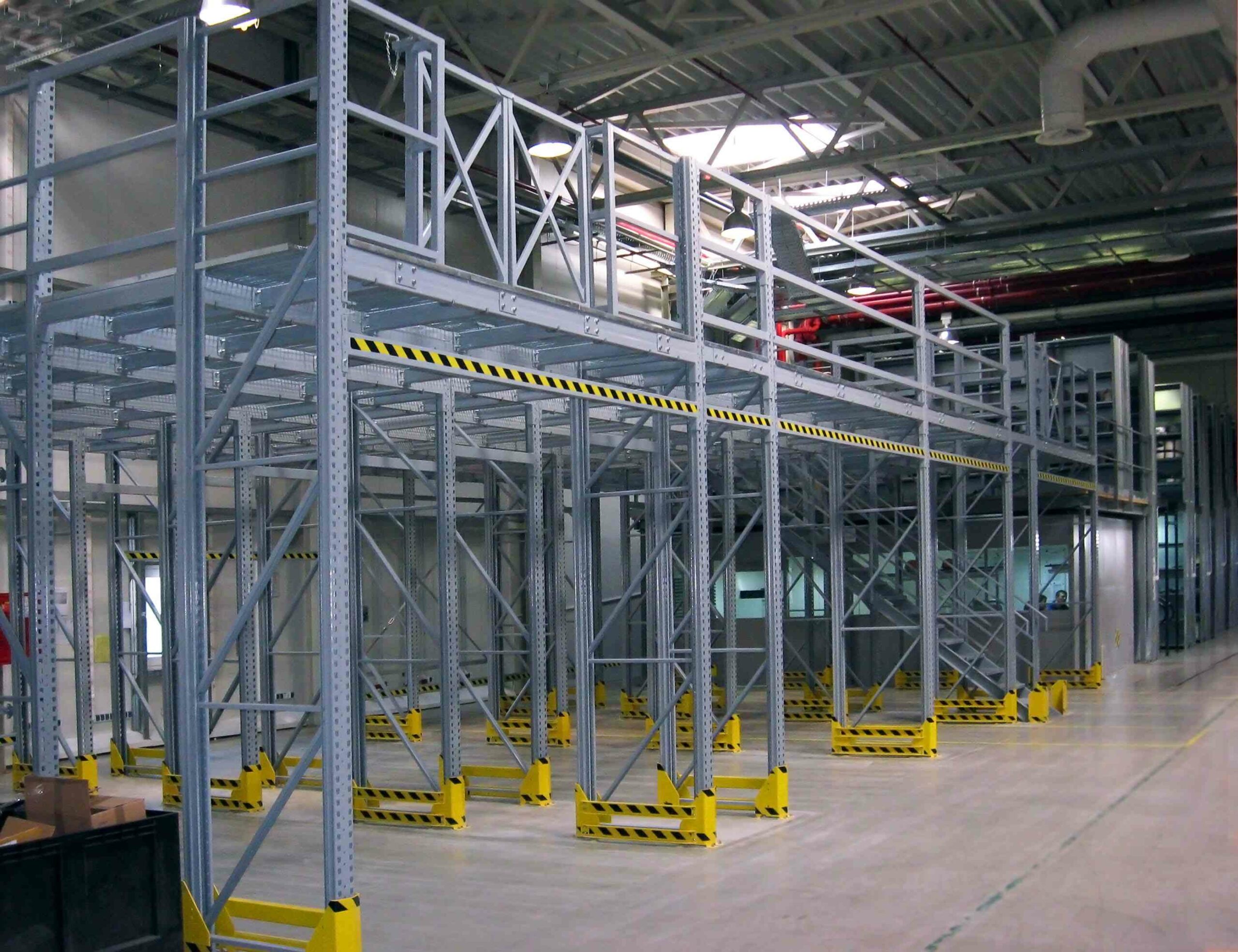Installing a mezzanine floor is one of the most effective ways to increase storage capacity and maximise usable space within a warehouse. Here, we explore the key benefits of mezzanine floors, design considerations, and how they can help optimise your warehouse storage and operations.
Mezzanine floors allow you to practically double your floor space by utilising wasted vertical space. This added storage capacity enables warehouse managers to accommodate inventory growth and new equipment without expanding premises. We’ll look at how mezzanine floors can optimise warehouse layouts and material flows.
What are Mezzanine Floors and How Do They Work?
A mezzanine floor is an intermediate floor constructed within a large industrial or warehouse building, positioned between the main floor and ceiling. Mezzanine floors can be installed as permanent structures or semi-permanent systems that allow reconfiguration.
Mezzanines effectively create a new floor within existing premises by utilising the vertical space above the ground floor. This added floor space can be used for storage, office space, extra production lines, or other operations. Mezzanines are typically constructed from steel and can support heavy pallet loads, shelving units, conveyors, and racking systems.
Mezzanines multiply the usable floor space while minimising the building footprint. They are much more cost-effective than moving or expanding warehouses to add space. Mezzanine floors are custom designed for each facility, with factors like building regulations, load capacities, and clearance heights considered. Stairs, pallet gates and goods lifts provide access between floors.
What Are the Key Benefits of Mezzanine Floors in Warehouses?
The benefits of mezzanine floors in warehouses are numerous. Firstly, they offer a highly cost-effective way to increase your storage space. You don’t need to invest in a whole new building or an expensive extension; instead, you can use your existing space more efficiently. Secondly, mezzanines are highly customisable. With expert design, you can tailor your mezzanine floor to meet the specific needs of your warehouse operation.
Beyond storage, mezzanine floors can also serve as extra office space or even a dedicated workspace. They are a versatile and practical solution for a wide range of needs, all while ensuring compliance with proper regulations.

How to Design and Build the Perfect Warehouse Mezzanine Floor Solution
Designing and building the perfect mezzanine floor solution starts with a thorough site survey to assess your existing space within your warehouse. This is an essential step to work closely with project managers and engineers who have experience in the design and installation of mezzanine floors. The aim is to identify the most effective methods for maximising both the floor and vertical space available.
Steps to Design the Perfect Mezzanine Floor:
- Site Survey: Conduct an extensive site survey to understand the available space within your warehouse and what you aim to achieve with the new floor.
- Consult with Experts: Consult with project managers and engineers with experience in mezzanine construction to tailor the design to your specific needs.
- Material Selection: Choose materials that are durable and appropriate for your warehouse environment.
- Pallet Gate Options: Decide on the type of pallet gate needed for the safe and efficient movement of goods between the ground floor and the mezzanine.
- Customisation: Work with mezzanine floor suppliers who offer bespoke mezzanine solutions, including the construction of the mezzanine platform and the installation of pallet racking systems or shelving units.
- Building Regulations: Ensure the design is in compliance with all regulations including fire safety and structural integrity.
- Installation: Once the design is finalised, proceed with the installation, ensuring all guidelines and safety measures are followed.
What Building Regulations Must Be Considered for a Mezzanine Installation?
Regulations are an essential aspect to consider when installing a mezzanine floor in your warehouse. These regulations are in place to ensure that your new floor meets safety standards, which include fire safety, structural integrity, and accessibility. Given that mezzanines often serve as additional storage or workspace, complying with these regulations is crucial for the well-being of your employees and the efficient operation of your business premises.
Consult professionals who have expertise in the design and build of mezzanines to guide you through this process. They can help you understand the planning permission for mezzanine floors, which is often required to ensure that the structure is legally compliant. Following these guidelines not only ensures the safety of your new floor but also helps avoid any potential legal implications down the line.
How Do Pallet Gates Work in a Mezzanine Floor System?
Pallet gates are an integral component of a well-designed mezzanine floor system. They facilitate the safe and efficient movement of pallets between the ground floor and the mezzanine. Given that your warehouse operation may involve various types of goods, selecting the right type of pallet gate is crucial.
Incorporating pallet gates into your mezzanine design ensures that you can easily move goods without compromising safety. These gates are particularly useful when you’re looking to increase storage capacity within your warehouse. They allow forklifts and workers to operate seamlessly across multiple levels, making your warehouse more functional and efficient.
How Can a Mezzanine Increase Storage Capacity within Your Business Premises?
A well-designed mezzanine floor can be a game-changer when it comes to increasing the storage capacity within your business premises. By leveraging the vertical space in your warehouse, you can create additional floor space for storing goods, equipment, or materials. This additional space allows you to better utilise your existing space, making it a cost-effective solution for businesses with growing inventory needs but limited floor space.
Utilising mezzanines for extra storage space is particularly beneficial for many warehouse environments where vertical space is often underutilised. The mezzanine floor allows you to install additional storage systems, such as racks and shelves, thereby transforming wasted vertical space into a usable storage solution. This is a particularly effective way to maximise the storage capacity within your warehouse without the need to move premises.

Pallet Racking vs. Mezzanine: Which is the Better Storage Solution?
Both pallet racking and mezzanine floors are popular choices when it comes to increasing warehouse storage capacity. However, the choice between the two often boils down to the specific requirements of your warehouse operations and the kind of flexibility you’re looking for. Below, we delve into the strengths and weaknesses of both.
Pallet Racking: The Go-To for Organised Storage
Pallet racking systems are particularly useful when you need a highly organised storage solution that allows for quick and easy access to goods. These systems are designed to accommodate pallets in a way that maximises space and efficiency. With pallet racking, you can easily use forklifts to access goods stored at different heights, making it a go-to option for many warehouse storage systems.
The primary advantage of pallet racking is its ability to significantly boost warehouse storage capacity without taking up a lot of area of the ground. It’s particularly well-suited for warehouses with a focus on inventory turnover and accessibility.
Mezzanine Floors: The Flexible Alternative
Mezzanine floors are often chosen for their flexibility and adaptability. Unlike pallet racking, which is primarily geared towards storage, a mezzanine can serve multiple functions. It can provide the extra space you need for storage, yes, but it can also be turned into office space, a workspace, or even a customer service area.
Moreover, mezzanines are cost-effective in that they make use of existing dead space within your warehouse. If you have a high-ceilinged warehouse, using a mezzanine floor can virtually double the usable space. This allows you to not only increase your storage capacity but also to create additional space to accommodate other business needs.
Space with a Mezzanine: A Multi-Tiered Approach
One unique possibility is the potential for a multi tier mezzanine floor. You can use the ground level for one function (e.g., a workspace) and the mezzanine for another (e.g., extra storage or office space). This kind of multi-purpose use of space is often not possible with traditional pallet racking systems
Do You Need to Move Premises or Can a Mezzanine Solve Your Space Issues?
If you’re facing space constraints, installing a mezzanine floor may eliminate the need to move premises. Mezzanines are an excellent way to maximize the space within your existing warehouse, making them a cost effective alternative to the expensive and time-consuming process of relocating.
Could a Mezzanine Floor Be the Solution for Your Warehouse?
If your business is rapidly expanding, a mezzanine floor allows for increasing storage capacity and optimising your warehouse layout cost-effectively within tight timelines.
Key benefits include doubling floor space, accommodating growth, improving zone layouts and material flows, adding modern storage systems, and avoiding costly relocation.
The PALLITE PIX System: A Game-Changer for Mezzanine Storage
The PALLITE PIX system is a groundbreaking solution for optimising mezzanine storage in warehouses. Built with honeycomb cell technology, each PIX unit can hold up to 500kg (1100 lbs), offering unmatched strength and durability. What sets it apart is its lightweight and modular design, making it ideal for mezzanine floors where weight considerations are crucial.
Ease of installation is another standout feature. The PIX units come flat-packed and can be quickly assembled without the need for specialised tools or installation teams. This quick deployment is especially beneficial for mezzanines, allowing for immediate utilisation of newly created space. Moreover, the system is forklift-friendly, eliminating the need for additional machinery and thereby cutting costs.
Designed for maximum space efficiency, the PALLITE PIX system features easy-to-fit interchangeable dividers that allow for customised storage solutions. It’s not just a temporary fix but a flexible, long-term solution that can adapt to seasonal demands and changing SKU profiles.
If you want to discuss the perfect storage system for a mezzanine, get in touch today and we’ll be happy to help.
Written by David Rose
FAQ
- What is mezzanine storage? Mezzanine storage refers to an intermediate level or platform constructed within a building, typically between the ground floor and ceiling. It provides additional space for storage, offices, or other purposes, effectively doubling the usable area without the need for expanding the building’s footprint.
- How much does mezzanine storage cost? The cost of mezzanine storage can vary significantly depending on factors such as size, materials, design complexity, and installation. It’s advisable to contact Pallite Group for a customized quote tailored to your specific requirements.
- Do you need permission to build a mezzanine? In many cases, obtaining planning permission or building regulations approval may be necessary to construct a mezzanine floor. The requirements can vary based on the location, purpose, and size of the mezzanine. It is advisable to consult with local authorities or Pallite Group to determine the specific permissions required for your project.
- Can a mezzanine floor be enclosed? Yes, a mezzanine floor can be enclosed or partitioned to create separate spaces or rooms, such as offices or storage areas. This flexibility in design allows you to customize the mezzanine to suit your specific needs.
- Why is mezzanine more expensive? Mezzanine structures can be more expensive due to factors such as the need for engineering and structural considerations, materials used, custom design, and installation. However, they are often a cost-effective solution for maximizing usable space within an existing facility when compared to expanding the building or relocating.
- Why is it called mezzanine? The term “mezzanine” comes from Italian and refers to an intermediate floor or level between two main floors. It is called so because it is typically positioned between the ground floor and another higher floor, serving as an intermediate level within a building’s structure.
